
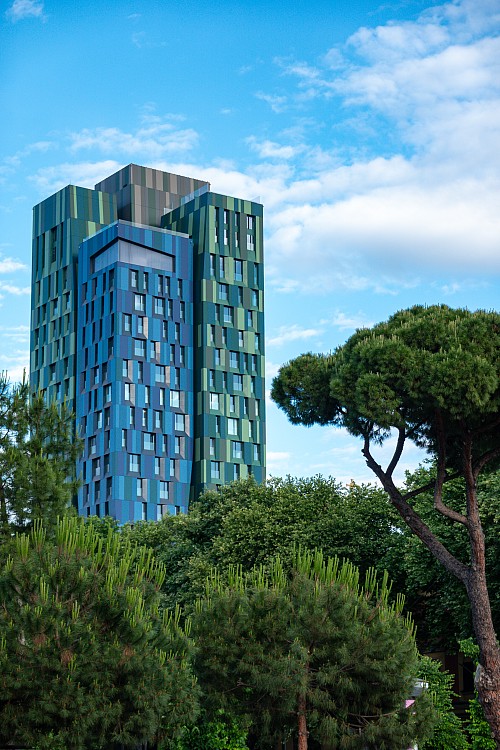

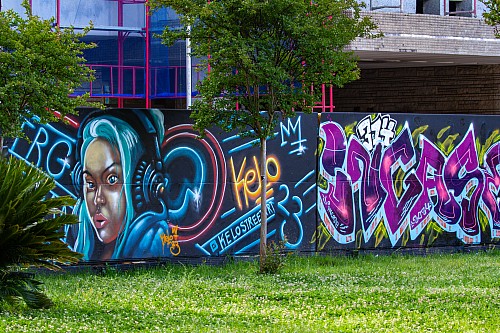
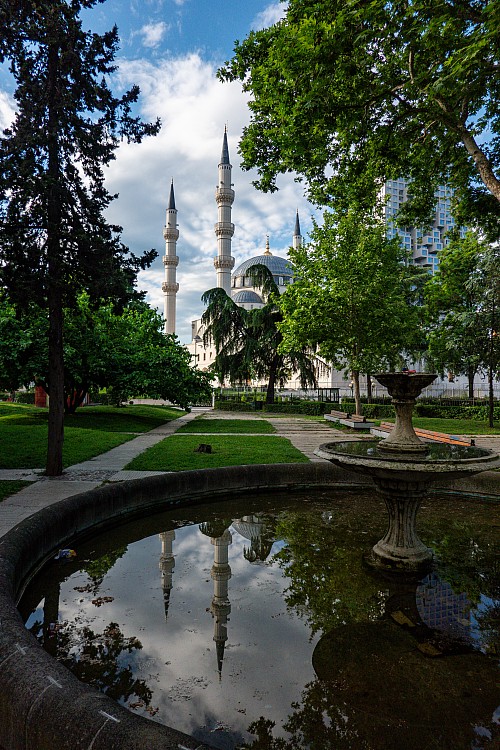

Justin got up around 06:30, and Crystal around 07:30. Justin realized that the plug he’d used to charge his phone, watch, and computer overnight was dead, so nothing had charged. He did a very brief charge after changing outlets, then went on a walk around town. He started by going up the Pyramid of Tirana, which was right next door. There were exterior steps on all sides of the pyramid, and good views of the Namazgah Mosque from the top. It was a nice sunny morning after all of the rain and gray skies the day before.
 |
 |
 |
 |
 |
 |
From the pyramid he walked across the Lana “river”, which was really more of a ditch, and then towards (and immediately past) the Tirana Castle, which was not a castle. He was right near the mosque now, and was circumnavigating it, trying to get the best angle. In the process he walked over the Tanners’ Bridge, a restored pedestrian bridge from the 1700s. From there Justin proceeded north, towards the New Bazaar, and then west through Skanderbeg Square, one of the largest squares he could remember seeing. He continued west on a commercial street, Rruga Myslym Shyri, and then south (going back across the river) into Blloku, where we’d been last night. He checked out a restaurant we’d identified whilst sitting at the Illyrian Saloon, called Smoke House Bar & Grill. The menu was on the outside of the window, and looked excellent. He then headed back to the hotel, now less than 10 minutes away, and got back around 08:30. He’d walked almost 7 kilometers this morning.
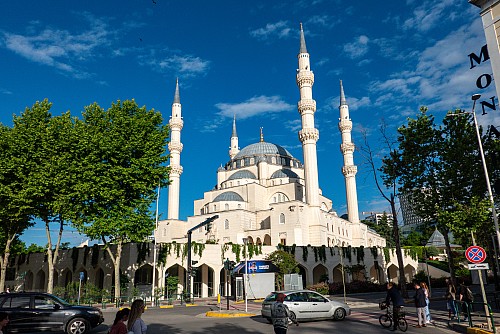 |
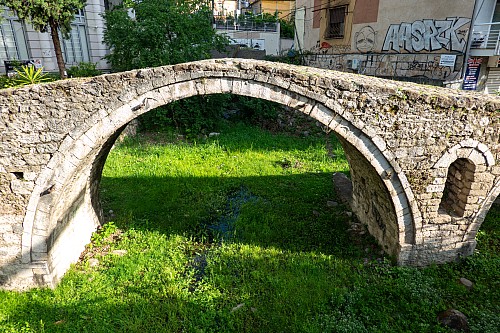 |
 |
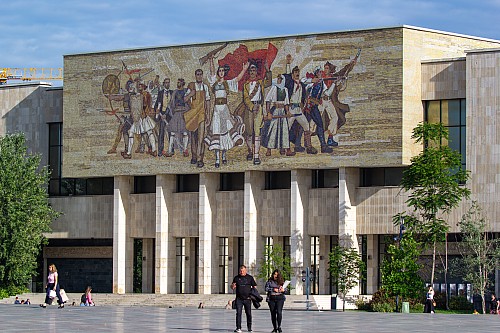 |
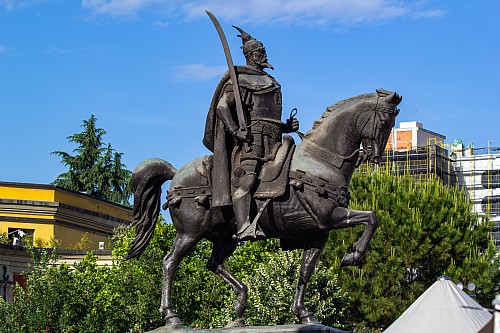 |
 |
We met everyone at 09:00, and walked south just a bit to a giant square, and up a bunch of steps at the Polytechnic University of Tirana. From the top of the steps, we had a great view down Bulevardi Dëshmorët e Kombit, the city’s main street. There were tons of cars everywhere, and it was clear that Tirana needs some sort of a subway and/or a tram. There were also a ton of “I ❤️ EU” signs up and down the street. From the top of the stairs, Adrian gave us some history about Tirana.
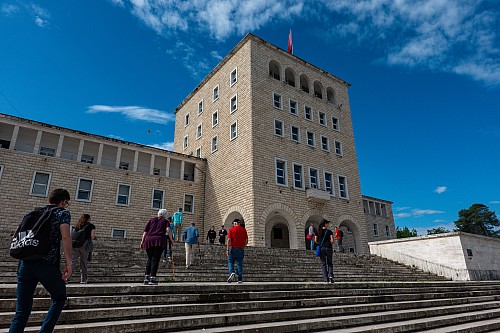 |
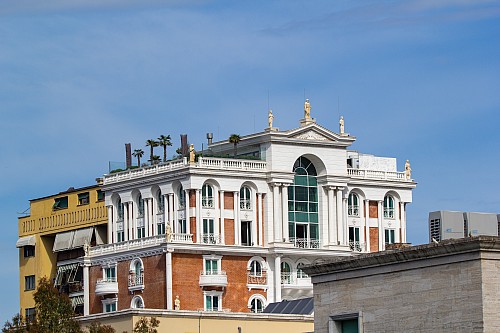 |
The city started in the 1600s as a small trading post, basically a small community of farmers. Then a mosque was built for Muslim caravans coming through the area, and then a Caravanserai was built, and then a Hammam, more shops, etc. The city grows slowly, but steadily for decades and decades. At some point, the 4 daughters of one influential family marry the 4 sons of another influential family, and the combined families then helped to speed up growth. But even by 1912 the city was quite small. There were grand plans in 1914 for the city, but then WW1 interfered with that. The Albanian government at this time was based in Durres, but it was universally reviled, and wasn’t helping protect the Albanian people.
 |
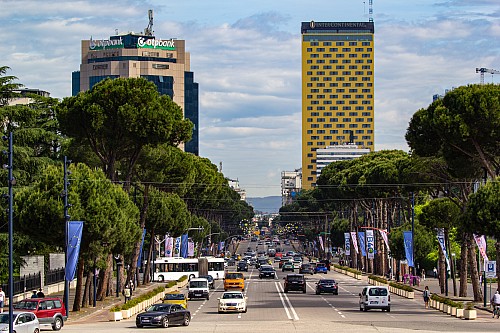 |
So the people built a new capital, and installed a new government, in Tirana. So from 1920-1939 there was rapid growth. The Italians helped out, but not altruistically, as they had ulterior motives to recreate the Ancient Roman Empire around the Mediterranean. Adrian told us that Bulevardi Dëshmorët e Kombit was a “boulevard without a city” – it was master planned to resemble a fascist symbol, and the giant square we were in front of was planned to be a meeting spot for fascist rulers to give speeches. In fact, in the building behind us, on the second floor there was a balcony built for Mussolini to address people, but he never ended up coming. And now the building is the faculty building for a university.
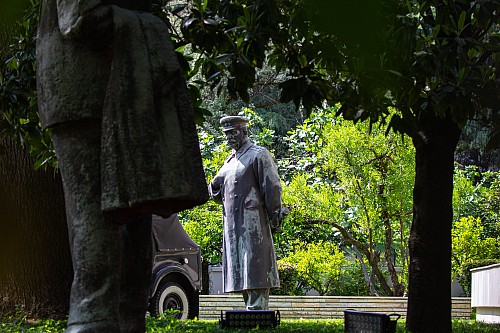 |
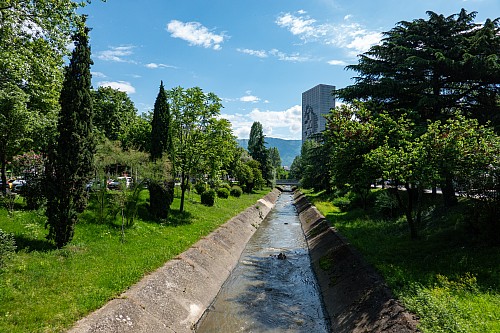 |
We headed north along the main drag, went past the President’s Office, and stopped briefly at “Checkpoint” where we saw a bunker, part of prison cell, and a piece of the Berlin Wall. The monument is intended to be a reminder of how people were at the mercy of the government during the communist era. Adrian told us how his life changed at 16, when the communist government crumbled and the rest of the world opened up to him. His whole childhood he’d been convinced that Albania was the best, strongest country in the world. Albania was completely isolated, but, to the Albanian people, this was because the US and USSR had agreed to conspire against Albania. The government allowed no outside news, to the point Adrian literally didn’t know that the Beatles existed. Then everything changed in an instant, and he realized basically everything he’d been led to believe had been a lie.
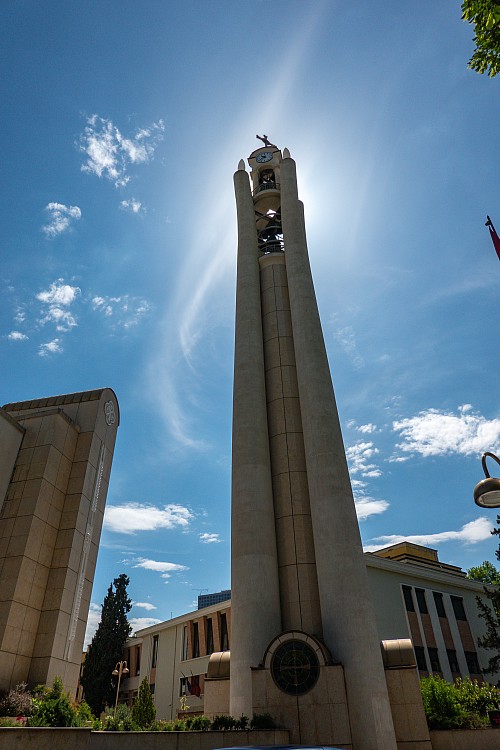 |
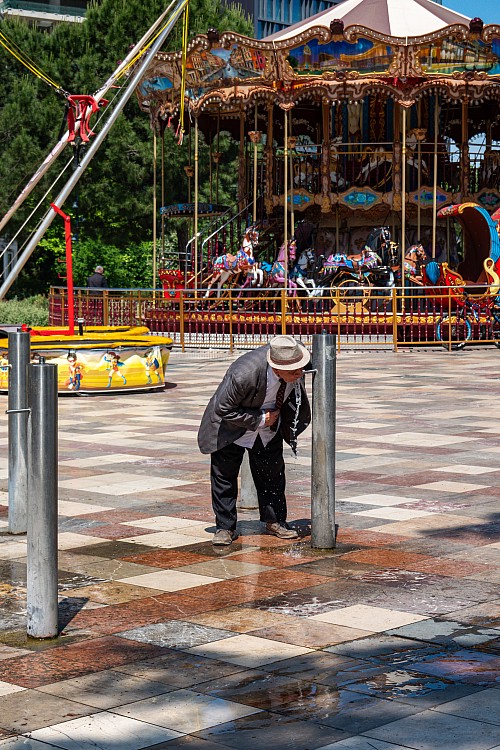 |
We walked west into Blloku, and along the way saw Lenin and Stalin statues that had been moved to much less prominent locations. We also saw the outside of Enver Hoxha’s former residence. He was the leader of Albania from 1944-1985, and was the person responsible for isolating the country from the rest of the world. Then we crossed over the river and stopped at the Resurrection of Christ Orthodox Cathedral. There was a huge clock tower and bell above the cathedral. We were inside for a bit, but at this point in the trip, most of the group was kind of over seeing another church. From there it was a short walk to Skanderbeg Square. There were public water fountains there, and we saw everyone from people in suits to homeless people using them (for different purposes). Adrian told us that the ground tiles was full of tiles from different parts of the country, as a means of connecting the country in a literal sense.
 |
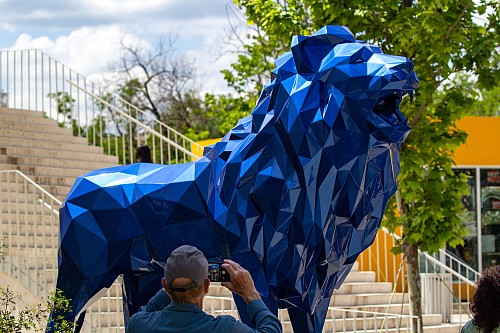 |
Next we walked to the “castle” Justin had gone by this morning. The influential family (from 4 the sons back in the day) had their property taken away during the Hoxha era, but then got it back in the 1990s. They then turned it into a bougie shopping area. We wrapped up our walk at the Tirana Pyramid. Originally it used to be a museum for Hoxha, and it was largely destroyed after the fall of communism. Afterwards young people would hang out in the area, and eventually it became a discotheque (The Mummy), similar to the Ruin Bars in Budapest. Eventually the government wanted to raze everything, start fresh, and build a new Parliament building there. But the citizens rebelled, and the government relented. So now it is a youth center, community center, and overall a symbol of change. There were several interesting animal statues around the Pyramid, including a lion, bear, gorilla, and more.
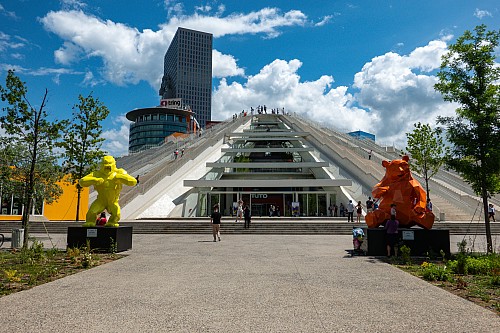 |
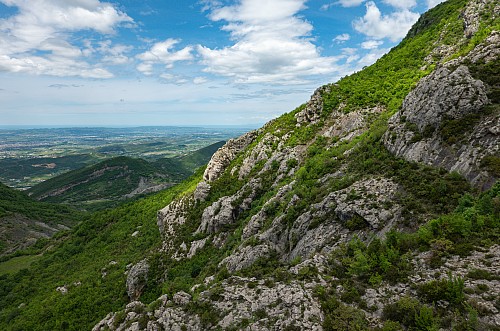 |
We all hopped in the van around 11:45, and everyone was happy to be seated, with the AC on, and with water. Drago took us east through town, where we got on a funicular for a long ride up into the hills. We were with Andy, Peter, Adrian, Drago, and Martin. We asked Adrian about how his daughter’s birthday went, and that transitioned into him showing us some of her artwork. We thought we were going to see “proud dad” artwork, but instead we saw “truly incredible artist” artwork. She had one drawing that she called “Lady Marble” that looked like it was in fact a 3D marble statue rather than a 2D drawing.
 |
After around 20 minutes we finally arrived at the top of Dajti Mountain, 1100 meters above sea level. Not surprisingly, we had great views from up top, and our table was right by the window overlooking the city and beyond. The lunch itself was fine, with the various breads being the best part. Our special guest, Mimosa (we’re not sure the exact spelling), was a big downer, being pessimistic about literally everything, and Alan did a great service to the rest of the group by jumping on the grenade and doing most of the talking, trying to get something positive out of her. The restaurant was quite loud, as it had been when we met with Omar in Sarajevo. The two of us eventually tuned her out and focused on the view, trying to orient ourselves and see what we could spot from our walk this morning.
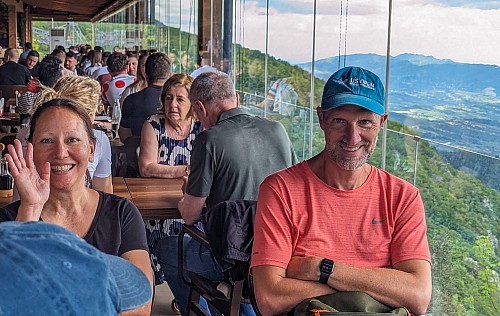 |
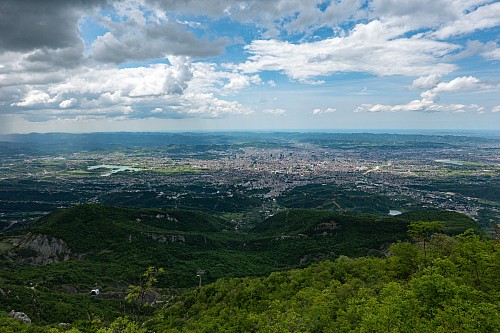 |
After lunch we went back down the funicular and went to Bunk Art, a historical museum built in a former bunker. Enver Hoxha had the country almost completely isolated, and one of the ways that he managed to keep the people under his thumb was to convince them that there was always a bigger and stronger threat from an outside source, which of course only he could protect them from. So defensive positions were built all around the country. Hoxha alienated himself from Krushchev in 1961, and a bit later Albania withdrew from the Warsaw Pact. Hoxha was worried for his personal safety, and his paranoia permeated down to the populace.
 |
 |
So much of the country’s wealth, for decades, was spent on bunkers and older military equipment. Tito had at least mentioned wanting to annex Albania, so around the Yugoslavian border bunkers were especially prevalent. There were bunkers in nearly every neighborhood as well, and within there were boxes with gas masks, food, and blankets. The Bunk Art museum was unique, interesting, but not that great of a spot for a longer visit at the end of the day. We got back in the van just after 16:00, and were back at the hotel around 16:45.
 |
We met Peter at 17:15 to go bar hopping. On our walk into Blloku we tried to get pictures of the Lenin and Stalin statues, but got waved off by some folks with uniforms, and they didn’t need to tell us twice. We were planning to go to N’Dashni, but they weren’t open yet, but fortunately another bar on our list, Nouvelle Vague, was just two doors down. Justin got a C’Est Rum (Pineapple, passion fruit, choco bitters, lime, blend of rums), and Peter and Crystal each got a Poppy (red apples, paprika, vanilla, bacon, blackberry raki, tequila). For the second round Justin got an Oriental (chestnut honey, fajitas mix, lime, orange liqueur, buttered tequila, mezcal), Crystal got a Quince (acacia honey, sumac, pistachio, single malt, quince raki), and Peter got a Deconstructed Negroni (fortified kallmet, bitter, juniper raki). Everything was very interesting, and very different from your average bar.
Then we walked two doors down to N’Dashni, and re-arranged our table to avoid smoke. Justin got something with cucumber and rum, Crystal got something with cinnamon and orange and whiskey, and we can’t recall what Peter ordered. We learned about his history, which was fascinating. He’d worked on Kings Road in London, doing music stuff, and in fact almost booked the Clash once. But then he transitioned careers, as he got his grades up enough to get his PhD, and thereafter he worked in the pharmaceutical industry for decades. Some of his friends and former colleagues are involved in the recent breakthrough at treating cerebral glioblastomas. So we got the impression, even if he never said it, that he’s kind of a big deal.
He was the next-youngest person on the trip, and he’d retired quite young and been traveling almost non-stop ever since, so we asked him about group trips usually work, and how representative this group was. He said we’re the youngest people he’s met on any of his trips, by around a decade, and the next youngest person he’d met was his current girlfriend, whom he met on a group trip in Pakistan. He said the majority of the guests are country counters. He said there aren’t a lot of couples, as many are at an age where they have had their spouses pass. He said, and we agreed, that it seems like we had a really good group.
When we tried to pay, we hadn’t ordered enough to cover the credit card minimum, so we got a round of Raki, then headed out for dinner at Smoke House Bar & Grill. We asked Peter if he wanted to come along, and he said it sounded good to him. At the restaurant there were combo plates for groups, so we ordered a Village Salad (tomatoes, cucumber, green salad, red onions, white cheese, olives, peppers, marinated with olive oil), the mixed grill 3 (250 grams of pork ribs, 250 grams of meatballs, 250 grams of sausage, and 250 grams of chicken filet), and a liter of red wine. Peter avoided the salad and the meatballs, as they had cheese. He has a cheese allergy that sounds serious enough that he should probably carry an epi-pen, but for whatever reason he doesn’t. The pork ribs were especially good. We finished all the meat, and the wine, and made a bit of a dent in the salad.
As we were wrapping up, we saw a group came in and wanted a table, but the restaurant was full. We got the impression the people were going to leave, so we got their attention and told them we were almost done. They stayed, and the proprietors were very happy with us for having done that, so they gave us a round of shots, and a group hug, to thank us. We walked back to the hotel, which was thankfully just a few blocks away. Peter went up to his room, and we walked over to the hotel bar for one last round. We were back in the room by 22:30, so we’d been galivanting around for a bit over 5 hours. We packed and got ready for the next morning so that we could sleep until our alarm.
| Previous Entry |